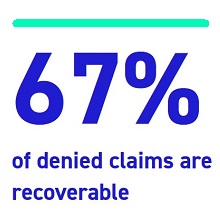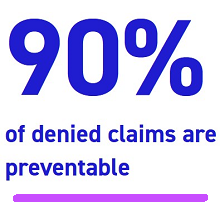Strategic Alternative Dispute Resolution Offers Providers Key to Substantial Claim Recoveries
By Lawrence A. Laddaga, JD, FHFMA, and Julia Dandridge | April 26, 2022 | From the HFMA
“Strategic alternative dispute resolution offers providers key to substantial claim recoveries “Strategy without tactics is the slowest route to victory. Tactics without strategy is the noise before defeat.”
—Sun Tzu, Art of War
Healthcare claim disputes between providers and payers occur daily, and although many are resolved by negotiation, such efforts occasionally fail. Sometimes the only way to resolve conflict is through the legal system, including litigation in court. If that recourse is adopted, however, it should be approached strategically, with an awareness that any managed care agreement will likely require some form of alternative dispute resolution (ADR).
To be able to effectively handle disputes over healthcare claims, providers must be well informed about the two basic types of ADR that can help them achieve favorable results: arbitration and mediation. The strategic use of arbitration, in particular, can play a pivotal role in such an effort.
ADR key elements defined
In any decision to pursue alternative dispute resolution (ADR), it is important to understand it is not simply a matter of choosing to go with mediation or arbitration. Rather, arbitration typically follows mediation. Here are definitions of the two terms that clarify this distinction.
Mediation is a process where both parties select a neutral third party to facilitate a settlement during a scheduled meeting between the parties. The selection of the neutral mediator should be outlined in the contract. Mediators are often lawyers, retired judges or healthcare executives who can lend an unbiased eye to both parties’ case’s strong and weak points, thereby making it easier to settle. Moreover, because mediation often results in settlement, and is cheaper than arbitration, it is recommended that contracts require mediation as a prerequisite to arbitration.
Arbitration is the next step in the process if it is not settled through mediation. Under arbitration, a neutral third party is appointed to function like a judge in a court hearing or trial, listening and reviewing evidence to render a decision. Arbitration is believed to be less formal, less expensive and quicker than a trial.
Why a knowledge of ADR matters now more than ever
Providers’ need for such knowledge has become more critical than ever following CMS’s publication on Oct. 7, 2021, of the interim final rule “Requirements Related to Surprise Billing; Part II” (86 FR 55980), which became effective Jan. 1. In essence, the rule is designed to protect patients from “surprise billing,” which refers to the balance billing patients receive when they have been treated by providers who are not included in their insurance networks, without their having been informed about the providers’ out-of-network status.
The rule requires independent dispute resolution arbitration as the sole legal means of resolving claim disputes in such situations.a With the rise in ADR in 2021 and this rule quickly coming into effect, it is essential now for providers to understand ADR, how it works, what it costs and what makes a good dispute contract clause.
ADR tactics and strategy
Taking inspiration from the words of Sun Tzu, if tactics are the resources at your disposal to resolve denied claims and payer disputes (in this case, arbitration is a tactic), strategy is the knowledge of how and when to deploy those tactics to maximize recovery at the lowest cost. Knowledge of ADR is of strategic value for providers because it gives them a significant advantage in resolving claim disputes. Three considerations make it clear why providers can benefit from acquiring such knowledge:
- ADR has become the preferred contractual requirement for resolving disputes by legal means.
- There are some denied claims that payers will never pay if the provider does not pursue ADR.b
- A provider can negotiate contract dispute provisions that reflect its best interest only if it understands ADR.
Let’s take a closer look at each of these considerations.
1 Increasing use of arbitration. The American Arbitration Association (AAA), one of the four large arbitration agencies in the United States, reported a 26% increase in healthcare-related cases filed in 2020.c AAA also reported having administered almost $1.2 billion in business-to-business (B2B) claims and counterclaims in 2020.
2 Strategic factors determining when to pursue ADR. Working denied claims, whether internally or outsourced, is a function of cost versus return. Within the universe of denied claims, the following circumstances are possible:
- Some are found to be properly denied.
- Some can be fixed by submitting a corrected claim, making a change in coding or fixing an inaccurate UB-04 claim form.
- Some involve a difference in opinion regarding a rule, regulation, law, contract or provision in the provider manual.
There also is a subset of claims the provider is convinced should rightfully be paid, while the payer has not provided a good reason for not paying it, and internal and external efforts have been unsuccessful in resolving the matter. The only way the provider can obtain payment for such claims is by legal means. And today, managed care contracts are likely to require the use of ADR in such instances.
Strategically, providers can benefit most from pursuing these types of claims. Yet they often are leery of using legal means in fear of wasting resources to no good effect.
Nonetheless, never using legal means is a mistake. When you truly stand up for what is right, whether your motivation is to defend a principle or to demand money you know you deserve, you are likely to command increased respect from the payer. Resorting to the legal process when it is important and strategic, therefore, will motivate your contractual partners to modify their behavior. It is important to not give up your due process rights.
3 How to address ADR in managed care contracts. Mediation and arbitration are essential to maintaining the cash and integrity of the revenue cycle because they are the only way to resolve claims when all other means have failed. It therefore is imperative that providers adequately consider the context, language and requirements of dispute-resolution provisions in their contracts with payers. Knowing the basic provisions that should be included to protect the provider when disputes arise is crucial to both strategy and cost.
Both parties can benefit from having a contract provision requiring ADR should a dispute arise because ADR is confidential and private, which is one reason such a provision is so often included in managed care contracts. Absent such a provision, parties are free to litigate in court, which one or both parties may prefer, but which also could give one party an unfair advantage over the other.
With this point in mind, providers should be careful in reviewing all of the language in their contracts’ dispute-resolution provisions. At a minimum, a dispute-resolution clause should:
- Define disputed
- Provide for a brief period to settle the issue prior to ADR and a clear timeline for providing notices to the other party, including when and how mediation is to be requested and how long mediation can progress before a party either may or must demand arbitration
- Avoid excluding any provisions of the contract, such as utilization review
- Provide for arbitration, using one arbitrator and specifying which service
- Provide for mediation specifying which service, where and how to give noticee
At a minimum, a dispute-resolution provision will ensure that unresolved contractual disputes are started by a provision of notice.
Clearly stating what service will be utilized is imperative. ADR is a privately contracted remedy, so if an organization does not use a national service with clear rules for the mode and way ADR progresses, it can see money wasted in arguments over process. It therefore is recommended that one of the four national services — AAA, JAMS, NAF or AHLA — be used.
Fees vary substantially among these services, even within different categories of the same services. The preferred fee structure is one that allows the organization to maximize the number of claims it brings in. It is important to consult with legal counsel in determining which service and fee structure is best for the organization.
Further, many dispute-resolution provisions in managed care contracts call for commercial rules rather than healthcare rules. But it stands to reason that it’s advantageous for both providers and payers to use healthcare rules. The premise is that you cannot effectively pick battles if you don’t know your battlefield or, in the case of ADR, the rules of engagement. Understanding how ADR is used allows you to successfully negotiate contracts where dispute resolution is an essential provision, not just a boilerplate.
Sometimes industries prefer contractually requiring arbitration because they see it as an appropriate barrier to litigating disputes in court, despite arbitration’s being more expensive to file and more difficult to pursue than such litigation. It nonetheless is a cost-effective option, meaning a well-drafted ADR provision might make claims as little as $10,000 cost effective to pursue. Conversely, a poorly drafted ADR provision might undermine the cost effectiveness of pursuing any claim less than $150,000.
Simply put, providers should have a reasonable option to pursue small claims. The limiting considerations should be the necessary allocation of resources and the strategic decisions, not the language in the contract.
‘The greatest victory is that which requires no battle’
This quote from Sun Tzu’s Art of War aptly describes the benefits of ADR: Healthcare finance leaders who have sophisticated knowledge and understanding of ADR are in the strongest position to recover substantial money in claims — which can amount to millions of dollars — with minimal conflict. Such understanding allows for a level of preparation and strategic execution that creates opportunities for victory without a battle.
The proliferation of contracts that limit legal means of resolving ADR disputes, combined with the increasing use of ADR as a requirement in statutes like the “surprise billing” rule, makes such knowledge indispensable. Why should a provider organization risk leaving money on the table that rightfully belongs to it or waive its rights, either knowingly or unknowingly, to resolve conflict with contracted partners?
Understanding ADR is an unmatched tool in your arsenal. It enables you to fairly negotiate dispute resolution provisions while also allowing you, in the event of a dispute, to make good strategic decisions and recover more money.
Footnotes
a. For example, HFMA, “Requirements Related to Surprise Billing, Part II Summary of Interim Final Rule with Comment,” Fact sheet, Oct 20, 2021.
b. In this case, ADR also refers to litigation where the contract does not require ADR.
c. AAA, “2020 B2B dispute resolution infographic,” 2021. The three other U.S. arbitration agencies are the Judicial Arbitration and Mediation Services (JAMS), the National Arbitration Forum (NAF) and the American Health Lawyers Association (AHLA).
d. A possible definition to include in a contract, for example, is “an alleged breach of contract that has not been resolved through previous informal or formal means including administrative appeals.”
e. Mediation is generally less expensive than arbitration, takes less time and — because both parties and their attorneys are usually well prepared — often results in settlement.




